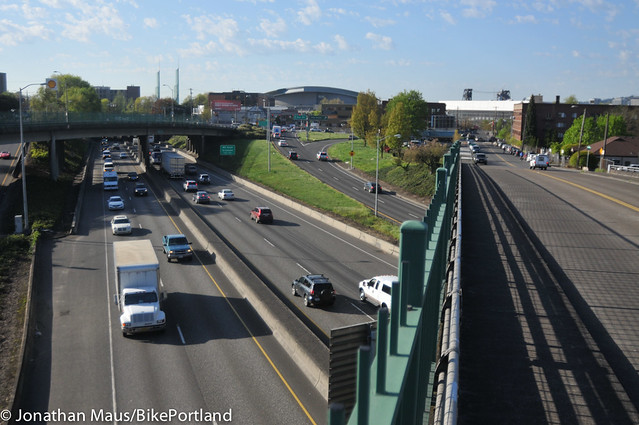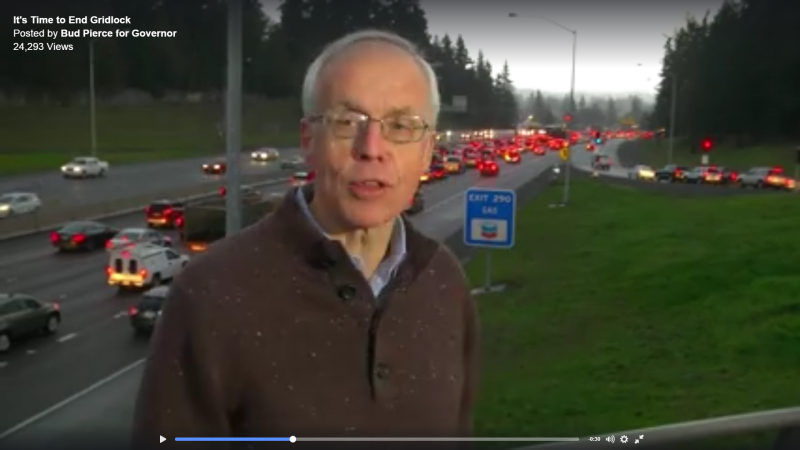Republican gubernatorial candidate Bud Pierce says he’s hit on an idea for solving the problem of people sitting in traffic on freeways: more travel lanes.
“Our current governor and government has no solution to our current gridlock,” he says in a new ad. “When I am governor, I will make sure we have added freeway lanes on all our major freeways. I’ll ensure that we have a new Columbia River Crossing bridge with added lanes. … Vote for Bud Pierce for governor and end gridlock once and for all.”
On his website, Pierce alludes to a “gas tax increase that goes primarily to build roads and bridges to ease gridlock.”
Since the state’s Constitution forbids spending gas taxes on anything but roads, that’s basically a longer way of saying “a gas tax increase” while getting in a false implication that more than a negligible amount of gas taxes ever go to anything else.
That said, let’s consider Pierce’s plan on the merits.

(Photos: J.Maus/BikePortland)
What would it cost to add a new lane to “all our major freeways”? Just for the Portland area, let’s assume he’s talking about the four he mentions (Interstate 5 and 205, U.S. 26 and state Route 217) plus Interstate 84.
Using the Troutdale and Hillsboro city limits on the east and west, the Columbia River on the north and the I-5/205 interchange on the south, that comes out to about 86 miles of freeway.
The Victoria Transport Policy Institute puts the cost of “urban highway capacity expansion” at $8 million to $12 million per lane-mile including land, development and construction. It’s not clear how that handles difficult points like the $350 million one at the Rose Quarter, but let’s say $10 million per mile.
Let’s also assume that by “lanes” Pierce means “one new lane in each direction.” (Though expanding capacity in one direction only might actually be a novel approach to traffic control.) That brings the cost to $1.7 billion.
Pierce also mentions a new Columbia River Crossing. Let’s take the $2.75 billion projected cost of that project as of 2013 and assume that Washington’s legislature would pay for half of it even without light rail, as long as it also didn’t have tolls.
Let’s also assume that road construction costs won’t inflate at all between 2013 and whatever year of the Pierce administration that construction would begin.
Advertisement
That brings the new bridge’s cost to about $2 billion, of which Oregon would be on the hook for $1 billion.
Pierce doesn’t mention that adding lanes to I-5 and I-205 would require new Marquam and Glenn Jackson bridges. To keep the costs down, let’s assume those bridges become bottlenecks.
This gives us a very rough estimate of $2.7 billion to add one lane to every overland freeway in the Portland metro area, plus a new Columbia River bridge.
This isn’t beyond the realm of possibility. The four-cent statewide gas tax hike proposed last year would have brought in $103 million annually, and some of these freeway widenings could probably get federal matching grants.

What about maintaining all that new pavement? That’d increase the future annual cost of the project, but not by so much that it’d fall apart.
There are still a couple problems with this plan, though.
One is that it raises taxes on people everywhere in Oregon but only widens freeways in Portland. Do all 308 miles of I-5 count as a “major freeway,” or all 371 miles of I-84? That’d at least quadruple the cost of Pierce’s plan, so maybe not.
His ad mentions “rural airports and rail improvements,” so maybe the idea is to win the support of Oregon’s rural population by promising to spend more lottery revenue on those projects.
The final question is the one raised by the very end of the ad: how widening freeways will “end congestion once and for all.”
If Pierce has discovered a way to make sure the next freeway lane is the one that never fills up, governments and taxpayers around the world will be overjoyed to learn about it.
— Michael Andersen, (503) 333-7824 – michael@bikeportland.org
BikePortland can’t survive without paid subscribers. Please sign up today.
Correction 12:10 pm: An earlier version of this article used $8 million per lane-mile for some figures and $10 million for others. It’s now adjusted to use $10 million, the middle of the VTPI cost range, throughout.


